The Bommai government has antagonised Kannadigas with its zeal to impose Hindi. Opposition to its imposition in the state can be traced to the pre-Independence era. The Gokak agitation in 1982 is the biggest language-related protest that has taken place in the state.
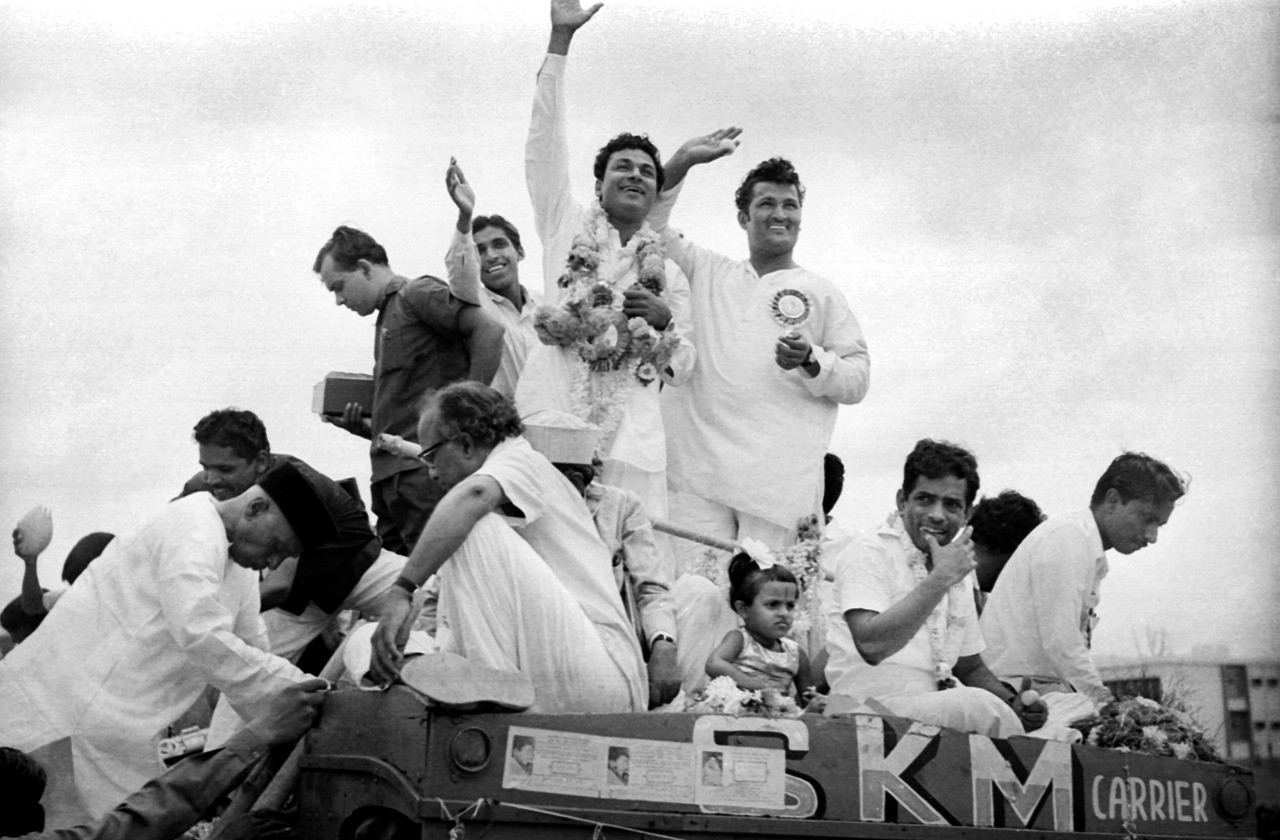
Kannada icon Rajkumar leads the Gokak agitation in 1982. Actors Narasimharaju and Balakrishna can also be seen (Kannada Dindima: History of post-unification Kannada struggle, RN Chandrashekar)
The report of the Official Language Committee headed by Union Home Minister Amit Shah on the use of Hindi in the country and the response it has evoked shows the tensions at play in the lead-up to the polls for the Karnataka Legislative Assembly in 2023 and Lok Sabha in 2024.
Implementation of the recommendations of the 11th volume of the report of the Parliamentary Committee on Official Languages — headed by Shah — to make Hindi a medium of instruction in central educational institutions will certainly be a Herculean task for the ruling Bharatiya Janata Party (BJP) in Karnataka, as the Bommai-led government has already antagonised Kannadigas in its enthusiasm to impose Hindi following the diktats of the Centre.
Understanding that the party and the government have touched on a sensitive issue and wounded the emotions of Kannadigas and Kannadatana (Kannadaness) and Kannada culture beyond repair, the BJP government organised the ‘Koti Kanta Gayana’ on Friday — in which nearly one crore people sang six classic Kannada songs — ahead of the 67th Kannada Rajyotsava celebrations on 1 November, Tuesday.
For the same reason, the BJP government also recently passed the Kannada Language Comprehensive Development Bill, 2022, in the Legislature. It provides reservation to Kannadigas in higher education and links incentives to industries with jobs for locals among other measures aimed at giving primacy to the language. The party claimed the move was a Kannada Rajyotsava gift for Kannadigas.
Surprisingly, though the Official Language Committee report is expected to be submitted once in every five years, the committee has tabled two reports in the last three years. This shows the eagerness of the Union government to promote Hindi.
Leaders of non-Hindi-speaking states are critical of the recommendations of the committee and have questioned its motives. Political and cultural leaders are of the opinion that the imposition of Hindi is nothing but an attack on autonomy of states and an insidious form of establishing cultural hegemony over non-Hindi-speaking states.
First and foremost to criticise the move of Centre in Karnataka is Janata Dal (Secular) leader H D Kumaraswamy. He dubbed the move of the Centre as the Amit Shah-led panel’s grand idea of “making India Hindistan”.
Kumaraswamy has been criticising attempts by the Centre to impose Hindi. He recently wrote to the Central government against conducting Staff Selection Commission exams only in English and Hindi. He firmly believes that the recommendations are detrimental to the federal structure of the country.
The BJP-led NDA government at the Centre has provided enough fodder for the ruling Congress in Karnataka for four years to vehemently oppose the imposition of Hindi.
Earlier, the Congress government headed by Siddaramaiah had gone to the extent of demanding a separate state flag for Karnataka and opposed anti-Kannada policies of the Centre, including delay in extending classical language tag facilities to Kannada.
Siddaramaiah, who started his journey into politics as the chairman of Kannada Kavalu Samithi (Kannada Watchdog Committee), has projected himself as the ‘guardian’ of the language throughout his political career. In the last two years, Siddaramaiah has continued to attack the pro-Hindi stand of the BJP government and succeeded in labelling it an ‘anti-Kannada, anti-Kannadiga’ dispensation.
In the process, though Siddaramaiah projected himself as a chauvinist, he did not allow any incident to dent his ‘saviour of Kannada’ image. He battled against the imposition of Hindi along with his namesake SG Siddaramaiah, the chairman of the Kannada Development Authority.
Related: Anti-Hindi agitations of Tamil Nadu reveal a sentiment too strong to be ignored
Since coming to power in 2019, the BJP government in Karnataka is in a dilemma whether to gratify Prime Minister Narendra Modi and Shah or oppose the imposition of Hindi tactically, without antagonising the party’s top brass. Basavaraj Bommai, who emerged as accidental chief minister, is not in a position to offend the Delhi leadership, unlike his predecessor B S Yediyurappa who projected himself as a pro-Kannada leader.
Knowingly or unknowingly, Bommai and his Cabinet colleagues, especially, C T Ravi, BJP national general secretary, and V Sunil Kumar, the minister of Kannada and Culture, are provoking the Kannada constituency.
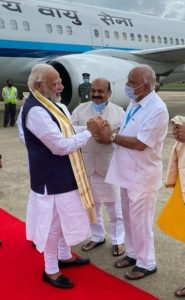
File photo showing Karnataka Chief Minister Basavaraj Bommai receiving Prime Minister Narendra Modi in Bengaluru along with former CM BS Yediyurappa
A recent trigger for Kannadigas to question the pro-Hindi stance of the government was the presence of Hindi on the official website of the Kannada and Culture Department. This issue embarrassed the ruling party and Bommai like never before.
This is not the first time that the BJP government has angered Kannadigas in its second tenure. Karnataka Governor Vajubhai R Vala addressed the joint legislature session in Hindi in January 2021 and attracted criticism for neglecting Kannada.
Union Home Minister Amit Shah’s visit to Shivamogga in January 2021 sparked outrage as the event in which he took part had banners entirely in Hindi. And a foundation plaque he unveiled did not have Kannada.
Former BJP MLC and president of the 86th Akhila Bharata Kannada Sahitya Sammelana Doddarange Gowda received flak during the same month for saying that Hindi is a national language. Later he tendered an unconditional apology for his statement while clarifying that he never meant to insult Kannada.
In September 2021, several Kannada organisations staged a protest at Mysuru Bank Circle against the imposition of Hindi by the government of Karnataka, which observed September 14 as Hindi Day in India. The protesters chanted that it was the “darkest day for Kannadigas”.
A government circular on the selection of students with knowledge of Hindi for a tour of Uttarakhand sparked a Hindi imposition row in June 2022.
It is not possible to forget the 2017 Hindi Beda campaign in Namma Metro or the pro-Kannada protest.
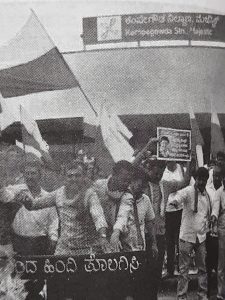
A protest against imposition of Hindi in Karnataka (Kannada Dindima: History of post-unification Kannada struggle, RN Chandrashekar)
The three-language formula adopted by the Indian government has once again brought one of the major questions to the fore as to why must Hindi be imposed on a diverse society such as India.
Besides these incidents, it is the apathy of the BJP government in taking forward issues pertaining to the Kannada anthem, the Kannada flag, and the controversy surrounding the Kannada Bhuvaneshwari statue that has angered Kannadigas. Bommai is being portrayed as a leader serving the interests of Delhi.
The BJP cadres are equally upset with the treatment being meted out to Kannada and culture in the two-year tenure of the present government.
In their attempt to strike a balance between the nationalist ideology and asserting regional identity, Karnataka’s BJP leaders have found themselves in a tricky spot. While they are appreciative of pro-Kannada programmes envisaged by BS Yediyurappa and DV Sadanand Gowda during their tenure, they are now worried about losing their vote base, which surpasses caste and creed, due to imposition of Hindi. In fact, there are BJP leaders who privately frown upon these developments because they are then forced to counter the narrative that theirs is a Hindi party.
Language bodies that are expected to protect the interest of Kannada look helpless.
The Kannada Development Authority (KDA) is being completely controlled by the Department of Kannada and Culture headed by minister V Sunil Kumar, a staunch pro-Hindi nationalist. Earlier the department was headed by CT Ravi.
Whenever the imposition of the Hindi issue crops up, both use their political power to silence the opposition. Similar is the predicament of Kannada Sahitya Parishat (KSP), the umbrella body of Kannada, Kannadiga, and Kannadaness.
Its present president, Manu Baligar, a former bureaucrat who won in the polls with the support of the BJP, never condemns the pro-Hindi moves of the BJP government. He limits himself to issuing a press note just raising objections to the government’s anti-Kannada policies.
Opposition to the imposition of Hindi can be traced to the pre-Independence era, K Rajakumar, former secretary of Kannada Sahitya Parishat, told South First.
“Aa. Na. Krishnarao [renowned Kannada novelist of the Navodaya literary movement, popularly known as Aa. Na. Kru], who was editing the Kannada Nudi-Newsletter of Kannada Sahitya Parishat, wrote an editorial opposing Rangarao Ramachandra Diwakar, popularly known as RR Diwakar, president of the 23rd Akhila Bharata Kannada Sahitya Sammelana held in Bellary in 1938,” recalled Rajakumar, an authority on the history of Kannada Sahitya Parishat.
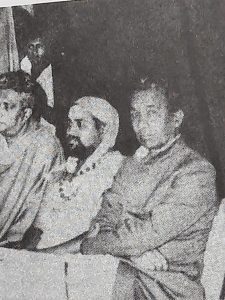
AN Krishna Rao (Aa Na Kru) at a Kannada Sahitya Parishat meeting (Kannada Dindima: History of post-unification Kannada struggle, RN Chandrashekar)
“In his editorial, Aa Na Kru accused Diwakar of imposing Hindi on Karnataka instead of promoting Kannada. The Executive Committee of KSP demanded an apology from Aa Na Kru for embarrassing the Parishat and Sammelana president. Aa Na Kru, who was known for his integrity, refused to do so. Instead, he resigned from the post,” he added.
In the post-Independence era, many writers opposed the imposition of Hindi by the Centre. The great Kuvempu, Jnanapith recipient litterateur, was amongst them.
“Kuvempu, along with other litterateurs of the time, opposed the attempts to impose Hindi in 1952 by RR Diwakar when he was a Union minister [in the Nehru government],” Rajakumar said.
In early 1994, when Bangalore Doordarshan introduced a 10-minute Urdu bulletin, there were riots in which people lost their lives.
“Renowned scholar M Chidananda Murthy, one of the loudest Kannada voices, formed the Hindi Samrajyashahi Virodhi Kriya Samithi (Hindi imperialist opposition Action Committee) and conducted various programmes to create awareness among the people on the danger of imposition of Hindi,” Rajakumar recounted.
Kannada cinema too did not compromise when it came to protecting the language.
The Gokak agitation in 1982 is undoubtedly the biggest language-related protest that has taken place in Karnataka.
The genesis of this massive Kannadiga movement is the recommendations of an expert committee headed by writer V K Gokak, Jnanapith recipient, to make Kannada as the first language mandatory.
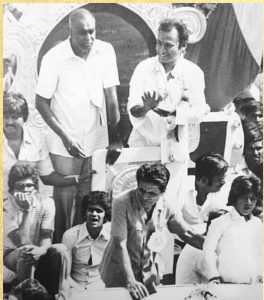
Actor Rajkumar during the Gokak agitation in 1982 along with political leader Ragupathy and Karnataka film producer Lakshman. In the front is Puneeth Rajkumar (Kannada Dindima: History of post-unification Kannada struggle, RN Chandrashekar)
“It is one of the biggest language-centric movements in post-Independent India. It has its origin in the much-contested three-language formula. When organisers of the Gokak agitation understood that litterateurs alone cannot make the movement successful, they appealed to Kannada icon Dr Rajkumar to support the movement. With the entry of Dr Rajkumar, besides common people, the entire Kannada film industry jumped into the movement and the agitation spread like wildfire,” RN Chandrashekar, noted Kannada activist, writer and Kannada movement historian, told South First.
“Probably in September 2006, the Karnataka Rakshana Vedike revived the anti-Hindi movement in Karnataka. Kannada activist Narayana Gowda along with his followers opposed the broadcasting of Hindi programmes. Narayana Gowda got arrested and cases were foisted on him,” recalled Rajakumar.
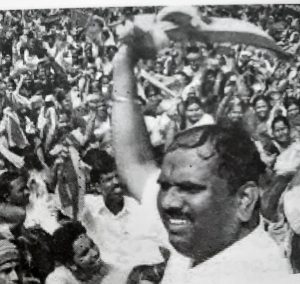
Narayana Gowda, Karnataka Rakshana Vedike leader (Kannada Dindima: History of post-unification Kannada struggle, RN Chandrashekar)
Similarly, other Kannada activists including Vatal Nagaraj led various kinds of movements protesting the imposition of Hindi. Even now he is actively protesting and cautioning the government of launching agitation of the Gokak movement kind.
It is significant that the Kannada film industry is opposing dubbing from other languages films and releasing Hindi films, which have become detrimental to the interest of Kannada cinema.
Recently, Kichcha Sudeep revived the memories of Dr Rajkumar when he took on Bollywood star Ajay Devgan head-on for his statement dubbing Hindi the national language. Kannada movies are now giving competition to Hindi films.
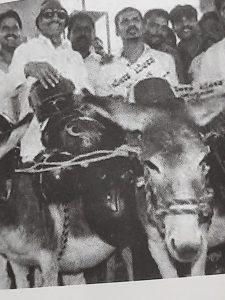
Vatal Nagaraj during a unique protest against imposition of Hindi (Kannada Dindima: History of post-unification Kannada struggle, RN Chandrashekar)
The Karnataka Rakshana Vedike (KaRaVe), the largest Kannada organisation, is strongly opposing the imposition of Hindi by the government. The group’s basic tenet is to spread awareness among non-Kannadigas about the language and culture of the land.
“It is difficult for non-Hindi speaking states to shrink dependence on English without popularising the respective regional language. They should be allowed to take the UPSC and bank recruitment exams in their respective languages. Prioritising Hindi will definitely be detrimental to the federal structure. It is necessary to bring an amendment to Article 343 of the Indian Constitution to accord primacy to all 22 languages in the Eighth Schedule,” Arun Javagal, state organising secretary of the Karnataka Rakshana Vedike, told South First.
(Muralidhara Khajane is a senior journalist, writer, and film critic. He is the author of ‘Random Reflections: A Kaleidoscopic Musings on Kannada Cinema’. These are the personal views of the author)

Jan 26, 2024

Dec 14, 2023

Oct 24, 2023

Sep 14, 2023

Aug 26, 2023

Jun 13, 2023